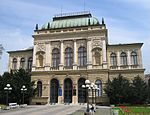Jakopič Pavilion
1908 establishments in Austria-Hungary20th-century architecture in SloveniaArt Nouveau architecture in LjubljanaArt Nouveau museum buildingsArt museums and galleries in Ljubljana ... and 6 more
Buildings and structures completed in 1908Buildings and structures demolished in 1962Demolished buildings and structures in SloveniaMax Fabiani buildingsRihard JakopičSlovenian art
The Jakopič Pavilion (Slovene: Jakopičev paviljon) was an art gallery in Ljubljana, the first purpose-built art exhibition venue in the territory of modern Slovenia. It was built in 1908 by the painter Rihard Jakopič upon the plans of the architect Max Fabiani. The pavilion stood at the beginning of the Latterman Avenue in Tivoli Park. Until World War II, it was the central exhibition place of Slovene visual artists, presenting exhibitions from the fields of painting, sculpture and photography.
Excerpt from the Wikipedia article Jakopič Pavilion (License: CC BY-SA 3.0, Authors).Jakopič Pavilion
Bleiweisova cesta, Ljubljana Rožna dolina
Geographical coordinates (GPS) Address Nearby Places Show on map
Geographical coordinates (GPS)
| Latitude | Longitude |
|---|---|
| N 46.053811111111 ° | E 14.498180555556 ° |
Address
Rihard Jakopič
Bleiweisova cesta
1102 Ljubljana, Rožna dolina
Slovenia
Open on Google Maps






